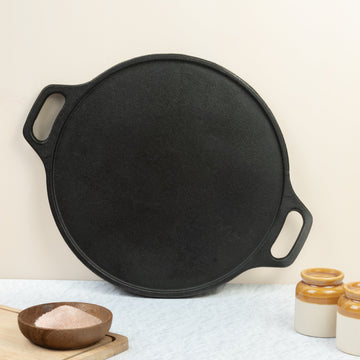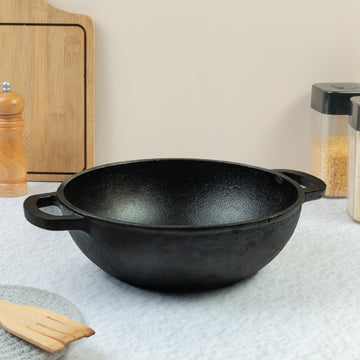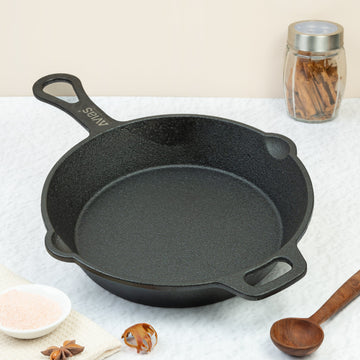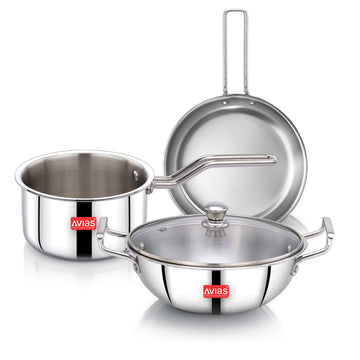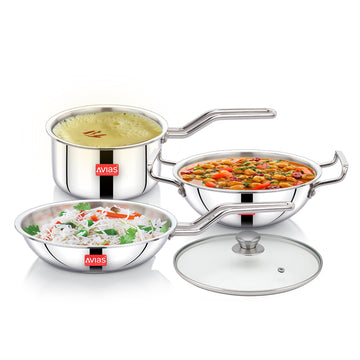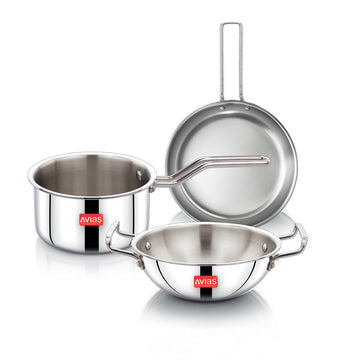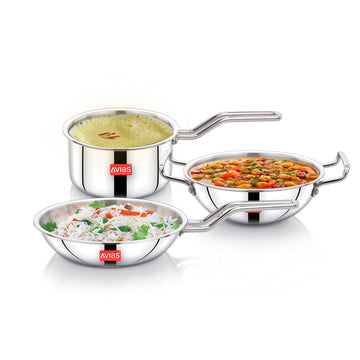Ceramic Cookware Vs Stainless Steel Cookware

Imagine you have shifted from refined oil to a wood-pressed oil, added more veggies and proteins into your diet, and even chucked out all the junk food in your cabinet. But did it ever occur to you that the best kitchen cookware sets that are used to cook your food on a daily basis can also have an adverse effect on your health? It is one of the least discussed yet one of the most defying factors of cooking healthy meals.
There is also a constant debate or confusion among consumers with regard to choosing stainless steel cookware or ceramic cookware. While both of these variants are well-established in the market, there is a clear winner in this regard. Let us put the debate to rest through this article below that shall gauge both these unique cookware materials considering the following factors:
1. Construction
2. Safety
3. Design
4. Heat Tolerance
5. Versatility
6. Sturdiness
7. Searing and Browning
8. Induction Compatible
9. Heat Distribution
10. Lifetime
11. Average Weight
12. Price
But before we delve deep into these factors and declare which type of cookware is the best, it is vital to understand the basics of both these forms of cookware. On the one hand, stainless steel is one of the best & most widely used cookware in the world. However, you might be taken aback by the fact that it is not a metal but an alloy- a culmination of metals, such as chromium and nickel, making it non-porous and highly resistant to corrosion.
On the other hand, ceramic cookware utensils come in two ranges: one is the 100% ceramic utensil that is made of clay and quartz sand, and the other (more prevalent in the market) variant is the “ceramic coated” non-stick cookware, which is, well, not really ceramic.
Let's dive deep into each of the factors mentioned above, and we’ll let you decide by the end of this blog on which type of cookware is best for your kitchen.
1. Construction
- The ceramic cookware set is made of clay and quartz sand, or the cheaper variant in the market is made of an aluminum core with ceramic non-stick coating. Either way, this construction makes it difficult to store or expose to high heat as they are prone to breakage and releasing toxins into the food.
-
Stainless steel cookware, on the other hand, is constructed with nickel and chromium. The Premium Stainless Steel Triply variant is a sandwich of stainless steel and aluminum, which distributes heat evenly and is known for bearing the brunt of rough use.
2. Safety
- The initial non-stick nature of ceramic cookware utensils lures most buyers into investing their hard-earned money into them. However, after a certain period, when the non-stick layers start peeling off, it not only reduces the non-stick capabilities but also releases toxins into the food.
- Stainless steel cookware utensils, on the flip side, are precisely what they claim to be. It can take up extremely high temperatures and does not have any coating that can leach into your food like uninvited guests.

3. Design
- Ceramic cookware is Instagram-famous for a reason. They are easier to manufacture in a wide range of colors and designs. Given their modern and colorful appearance, they are more popular among the new entrants into the world of cooking.
-
The stainless steel cookware sets are a wee bit towards the traditional side of design. They are slightly sturdier and sleeker in appearance. While they are more towards the traditional riveted handles and sandwich bottoms side, their mirror finishes and glossy looks culminate to give them a classy look.
4. Heat Tolerance
- Even though most ceramic utensils are marketed as safe for cooking at high temperatures, sustained exposure to high heat can lead to the ceramic coating breaking down quickly. On average, they can tolerate up to 220°C (450°F) but not on a regular basis.
-
Premium stainless steel cookware and heat tolerance are a match made in heaven. They can tolerate 260°C (500°F) easily on average, and their even heat distribution gives them an edge over other types of cookware in the market.
5. Versatility
- Ceramic cookware is primarily associated with cooking light dishes. They cannot withstand the spice-heavy, double-fry, and extreme conditions of Indian cooking.
- Stainless steel cookware, on the other end of the spectrum, is famous for its ability to withstand rough use and cook a wide range of dishes that involve frying, searing, browning, or even braising.

6. Induction Compatible
- Ceramic cookware is compatible with inductions and other cooktops if the bottom is made of steel. Otherwise, they can only be used on gas stoves.
- Stainless steel cookware is compatible with induction, ceramic cooktops, and gas stoves as efficiently as one another.
7. Heat Distribution
- When on low to medium heat, ceramic cookware distributes heat evenly across the utensil, as ceramic is a very good conductor of heat. However, with high temperatures, there are risks of hot spots that can lead to uneven cooking.
-
Stainless steel kitchen utensils, with their triply construction, provide superior heat distribution and allow food to be cooked evenly according to the temperature needs of the dish.
8. Lifetime
- Due to the very nature of the silicon oxide coating on ceramic cookware, every time you heat your pan, the coating releases naturally. Therefore, the average lifetime of ceramic cookware is between 1 and 3 years.
- Stainless steel cookware has been hailed as one of the most durable materials for cooking. In fact, many families pass on these utensils as a sign of generational wisdom in the world of cooking. The average lifetime of a stainless steel cookware is between 10-15 years.
9. Average Weight
-
The average weight is significant in this comparison as the higher the weight, the better the changes in its longevity. Ceramic cookware is generally more lightweight in comparison to its stainless steel counterparts. While a ceramic fry pan weighs anywhere between 2-3 pounds (1.3 kg approx.), a stainless steel fry pan weighs anywhere between 4-5 pounds (2.3 kg approx.)
10. Price
- In general terms, the price of any product or commodity is linked to its longevity. Naturally, ceramic cookware is priced slightly lower than stainless steel on average. However, most consumers believe that stainless steel provides more value for money than any other material in the market.
While choosing the best cookware for your kitchen, we often consider design, price, and how long it would last. What we often miss is that irrespective of how healthy your ingredients are, they can all be ruined due to the cookware material you choose.
Through the ten comparative points above, ceramic cookware had an edge over stainless steel cookware in two criteria- design and heat tolerance. But what good does it look if it is not healthy or does not last for even a few years? Therefore, it is safe to say that stainless steel cookware emerged as a unanimous winner through the detailed comparison above.
It is not a surprise that even the most famous chefs across the globe have stainless steel utensils in their commercial kitchens. What are you waiting for? You can choose from Avias’s comprehensive range of premium stainless steel cookware. That way, all you have to concentrate on is making food, while Avias takes care of the quality, durability, and design of the utensils for you.
Happy Cooking!
